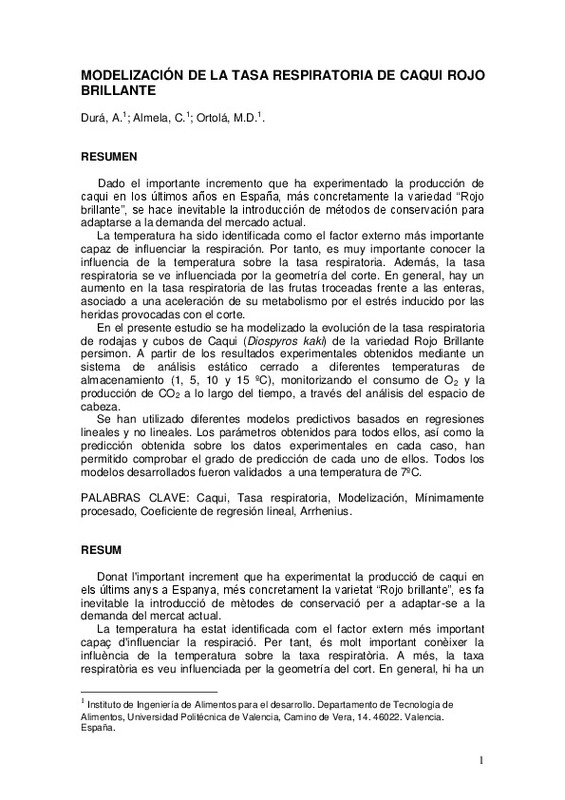JavaScript is disabled for your browser. Some features of this site may not work without it.
Buscar en RiuNet
Listar
Mi cuenta
Estadísticas
Ayuda RiuNet
Admin. UPV
Modelización de la tasa respiratoria de caqui rojo brillante
Mostrar el registro sencillo del ítem
Ficheros en el ítem
| dc.contributor.advisor | Ortolá Ortolá, Mª Dolores
|
es_ES |
| dc.contributor.author | Durá de Miguel, Ángela
|
es_ES |
| dc.date.accessioned | 2012-01-20T10:50:47Z | |
| dc.date.available | 2012-01-20T10:50:47Z | |
| dc.date.created | 2010 | |
| dc.date.issued | 2012-01-20 | |
| dc.identifier.uri | http://hdl.handle.net/10251/14455 | |
| dc.description.abstract | Dado el importante incremento que ha experimentado la producción de caqui en los últimos años en España, más concretamente la variedad "Rojo brillante", se hace inevitable la introducción de métodos de conservación para adaptarse a la demanda del mercado actual. La temperatura ha sido identificada como el factor externo más importante capaz de influenciar la respiración. Por tanto, es muy importante conocer la influencia de la temperatura sobre la tasa respiratoria. Además, la tasa respiratoria se ve influenciada por la geometría del corte. En general, hay un aumento en la tasa respiratoria de las frutas troceadas frente a las enteras, asociado a una aceleración de su metabolismo por el estrés inducido por las heridas provocadas con el corte. En el presente estudio se ha modelizado la evolución de la tasa respiratoria de rodajas y cubos de Caqui (Diospyros kaki) de la variedad Rojo Brillante persimon. A partir de los resultados experimentales obtenidos mediante un sistema de análisis estático cerrado a diferentes temperaturas de almacenamiento (1, 5, 10 y 15 ºC), monitorizando el consumo de O2 y la producción de CO2 a lo largo del tiempo, a través del análisis del espacio de cabeza. Se han utilizado diferentes modelos predictivos basados en regresiones lineales y no lineales. Los parámetros obtenidos para todos ellos, así como la predicción obtenida sobre los datos experimentales en cada caso, han permitido comprobar el grado de predicción de cada uno de ellos. Todos los modelos desarrollados fueron validados a una temperatura de 7ºC. ABSTRACT: Given the important increase that has undergone the khaki production in the last years in Spain, more concretely the "Rojo brillante" variety, is made the introduction inevitable of conservation methods to adapt to the demand of the present market. The temperature has been identified as the more important external factor able to influence the breathing. Therefore, it is very important to know the influence of the temperature on the respiratory rate. In addition, the respiratory rate is influenced by the geometry of the cut. Generally, there is an increase in the respiratory rate of the fruits divided against the whole ones, associated to an acceleration of his metabolism by the stress induced by the wounds caused with the cut. In the present study, it has modelled the evolution of the respiratory rate of slices and buckets of Khaki (Diospyros kaki) of the "Rojo Brillante" variety persimon. From the obtained experimental results by means of a system of closed static analysis to different temperatures from storage (1, 5, 10 and 15 ºC), monitoring the consumption of O2 and the CO2 production throughout the time, through analysis of the head space. Different predictive models based on regressions linear and nonlinear have been used. The parameters obtained for all of them, as well as the prediction obtained on the experimental datas in each case, has allowed to verify the degree of prediction from each of them. All the developed models were validated to a temperature of 7ºC. | es_ES |
| dc.format.extent | 20 | es_ES |
| dc.language | Español | es_ES |
| dc.publisher | Universitat Politècnica de València | es_ES |
| dc.rights | Reserva de todos los derechos | es_ES |
| dc.subject | Caqui | es_ES |
| dc.subject | Taxa respiratòria | es_ES |
| dc.subject | Modelització | es_ES |
| dc.subject | Mínimament processat | es_ES |
| dc.subject | Coeficient de regressió lineal | es_ES |
| dc.subject | Arrhenius | es_ES |
| dc.subject | Khaki | es_ES |
| dc.subject | Respiratory rate | es_ES |
| dc.subject | Modelling | es_ES |
| dc.subject | Minimally processing | es_ES |
| dc.subject | Coefficient of linear regression | es_ES |
| dc.subject | Tasa respiratoria | es_ES |
| dc.subject | Modelización | es_ES |
| dc.subject | Mínimamente procesado | es_ES |
| dc.subject | Coeficiente de regresión lineal | es_ES |
| dc.subject | Persimon | es_ES |
| dc.subject.classification | TECNOLOGIA DE ALIMENTOS | es_ES |
| dc.subject.other | Máster Universitario en Gestión y Seguridad Alimentaria-Màster Universitari en Gestió y Seguretat Alimentària | es_ES |
| dc.title | Modelización de la tasa respiratoria de caqui rojo brillante | es_ES |
| dc.type | Tesis de máster | es_ES |
| dc.rights.accessRights | Abierto | es_ES |
| dc.contributor.affiliation | Universitat Politècnica de València. Servicio de Alumnado - Servei d'Alumnat | es_ES |
| dc.description.bibliographicCitation | Durá De Miguel, Á. (2010). Modelización de la tasa respiratoria de caqui rojo brillante. http://hdl.handle.net/10251/14455 | es_ES |
| dc.description.accrualMethod | Archivo delegado | es_ES |






